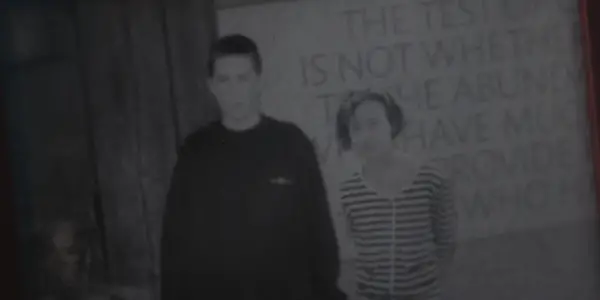One thing about modern horror that has tended to happen is that underlying or interpretive elements of trauma have become surface elements. They explicitly find themselves in the text of the script, relaying a lot of the subliminal manifestations of horror as verbal expression. This has tended to make a lot of modern horrors less focused on the memorable visual communication and sensory aspects associated with great horror films in the past in order to signal the movie is about something important. This is the heart of why a movie like When I Consume You is disappointing despite its cast and filmmakers’ best efforts. It looks and feels like a movie that has a lot to say but the words and expressions that come out and the visual canvass that is used to relay it, end up being clumsily stitched together.
Just Sound and Fury
I try to give indie movies the benefit of the doubt because of their narrow budget and well-meaning attempts at compelling art but in the end if something simply fails to connect then that needs to be analyzed as to why. What I noticed in this film is that there’s nothing backing up the sound and fury of its character’s anxiety and trauma.

The movie relies on a lot of emotive markers – heavy breathing, heavy cursing, talking about the violence of the past, panic attacks, and creaks and squeaks in unknown dark corners – but they come and go as a means of trying to conjure up fear artificially instead of allowing it to build through mood. The central character – brother and sister – of the film are the movie’s most potent dramatic core. Their relationship is established by their wildly differing personality traits. Daphne Shaw (Libby Ewing) is aggressive, type-A, but also often out of control and suffers from a level of hot-headedness that needs to be cooled down by her brother Wilson’s (Evan Dumouchel) more timid and introspective demeanor. Their bond is shared in this life and into the after-life after Daphne is killed by their stalker (the police conclude it was a drug overdose).
Cutting the Tension
The movie jumps back and forth in the timeline to reveal new information about their parents and their past with the stalker, but a lot of this is narrative trickery that doesn’t really render into feeling and importance. It feels like the movie doesn’t really know how to add depth to its own story so it needs to layer its characters’ traumas deep inside of narrative packaging.
The result becomes rather tedious and unengaging. Even when the stalker is eventually revealed, in the tensest moment after he reaches his hand inside Wilson’s soul the movie cuts to a quiet moment of the siblings talking about the Buddhist philosophy of the world as an ocean and people as waves. The tonal inconsistencies, while aiming to create connections between past and future, lose the dramatic developments.
Conclusion:
For When I Consume You, the strength lies in the movie’s ability to make the most with a small budget, but it cannot mask the shortcomings of an uncompelling story. If indie-horror is your thing, then certainly give this a try because there are some visual tricks that filmmakers working with a low budget could find interesting. Though, many scenes feature a lot of cliché elements we’ve seen many times in horror like creepy drawings and cult stick figures and whatnot. But from a narrative standpoint, it wears trauma and affliction on its sleeve while failing to embed those things in the movie’s fabric. It jumps around creating light-hearted moments and flashback sequences where they ruin build-up instead of adding to it. Sorry to say, it didn’t consume me.
When I Consume You Released on VOD on August 16th, 2022.
Watch When I Consume You
Does content like this matter to you?
Become a Member and support film journalism. Unlock access to all of Film Inquiry`s great articles. Join a community of like-minded readers who are passionate about cinema - get access to our private members Network, give back to independent filmmakers, and more.